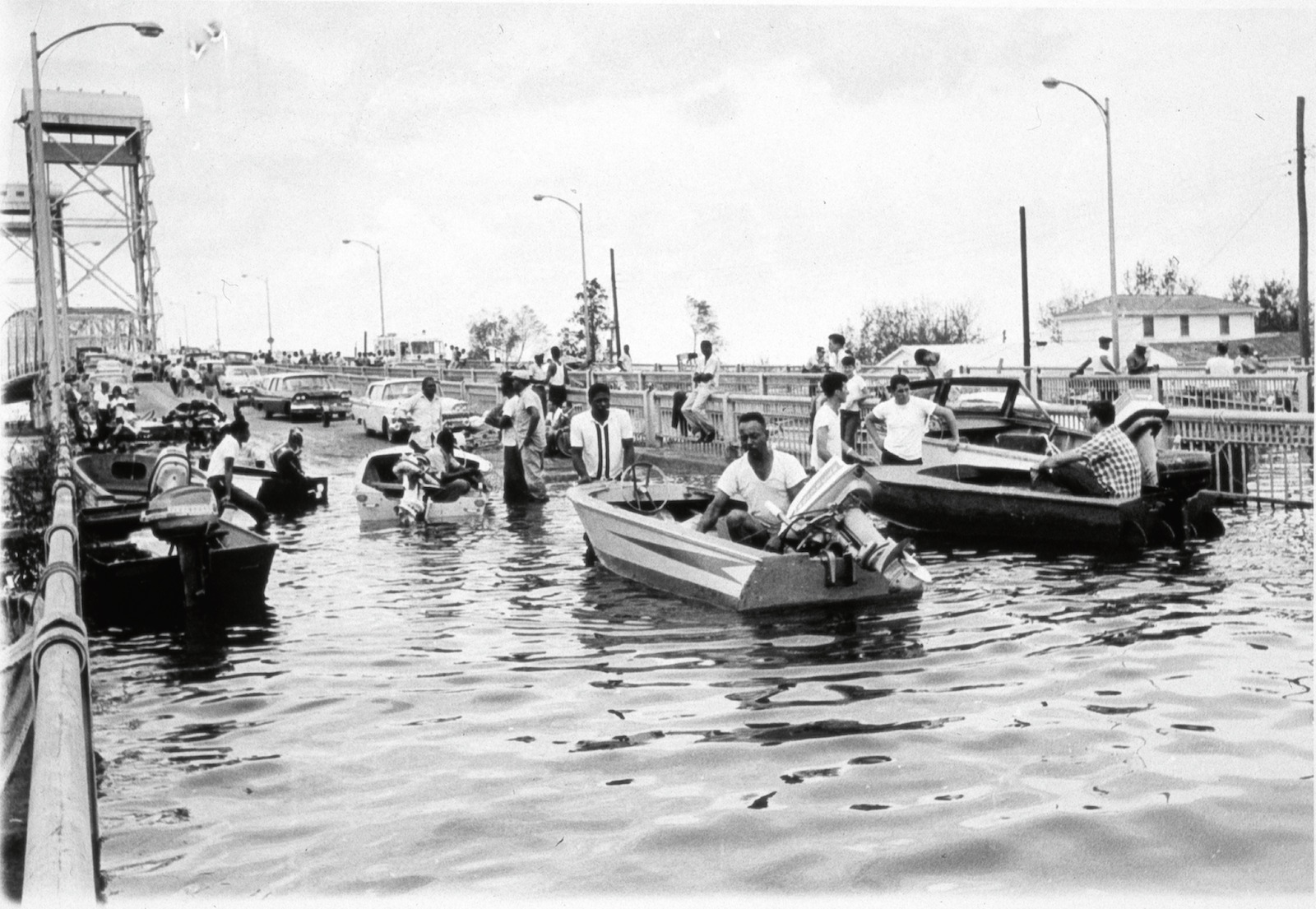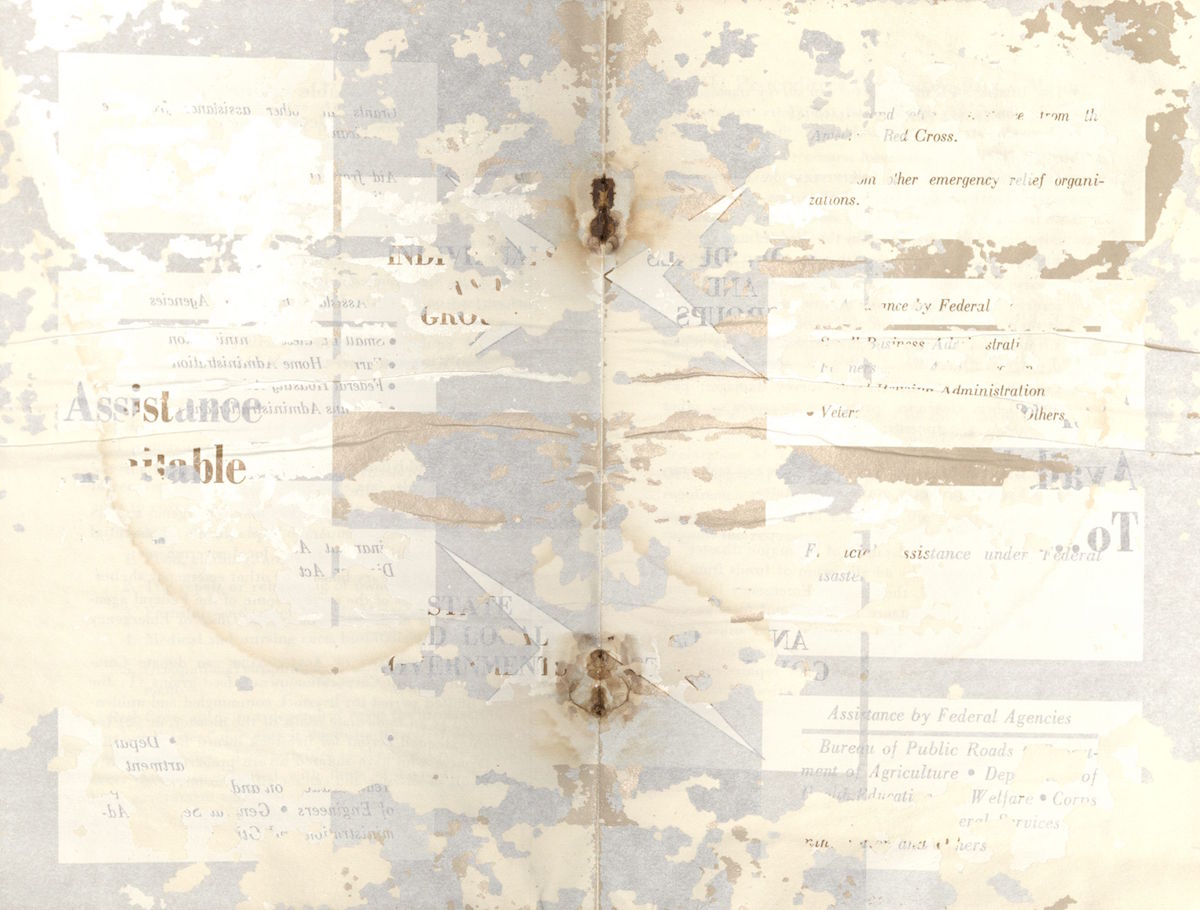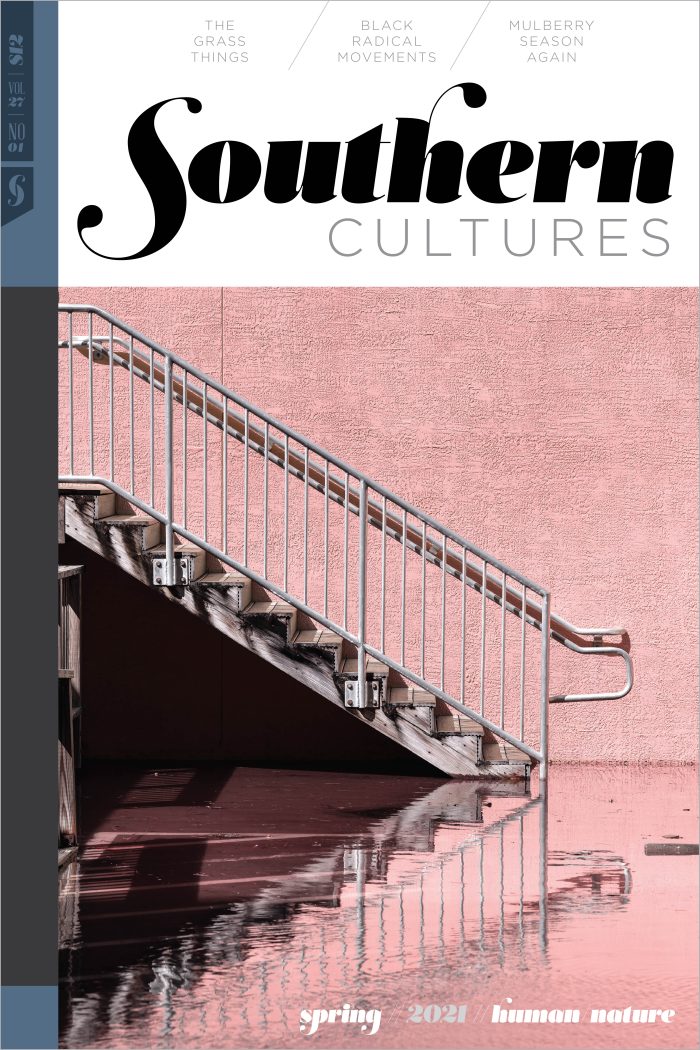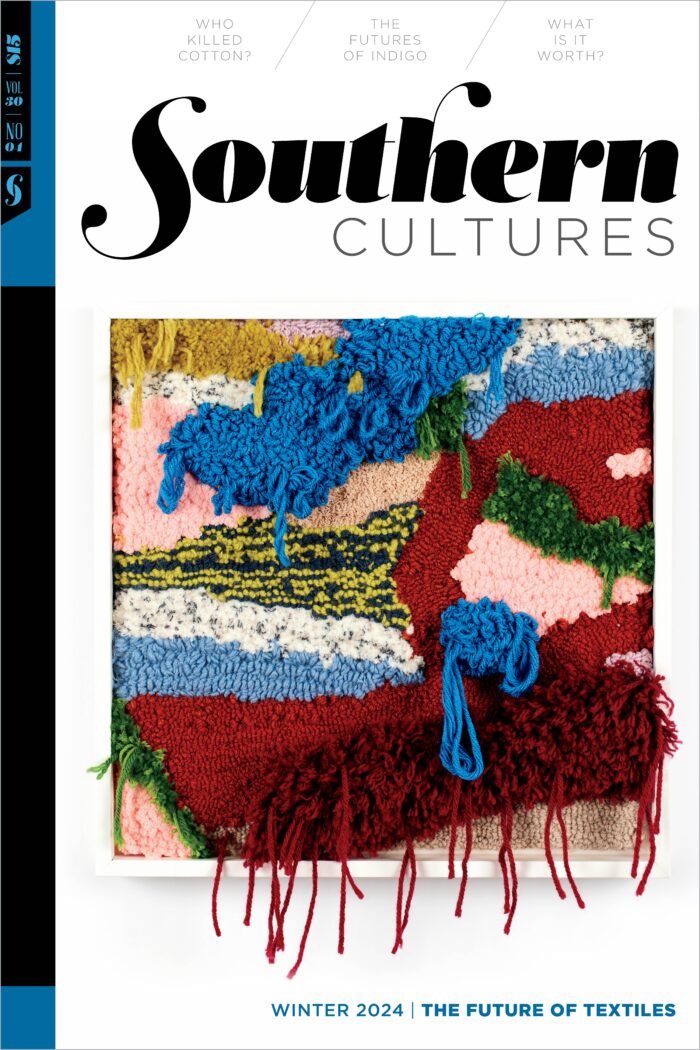On November 1, 1952, the United States detonated a hydrogen bomb on Elugelab, a small island in a chain of coral islands in the Pacific Ocean called Enewetak Atoll. As the mushroom cloud cleared, two F-84 jets flew over the site. Their cameras documented an absence. Elugelab was gone. In its place was a crater nearly the size of the Pentagon. Within about a week, a thin layer of plutonium—fallout from the explosion—covered the entire earth.1
This radioactive film defines the current epoch in the world’s history. Or, at least, that seemed to be the consensus among the geologists who comprised the Anthropocene Working Group when they gathered in New Orleans in November 2019. To dig into the ground and observe its stratigraphic layers is to travel through time, and the band of plutonium lying just beneath the earth’s surface from the Elugelab explosion and other nuclear tests from that period offer the earliest definitive, uniform, and ubiquitous mark of the human hand on the earth’s geology. Thus, the scientists name our era “the Anthropocene”—the age of humans—and announce this nuclear dust as heralding the arrival, in a geological sense, of human history.2
The Anthropocene Working Group meeting was planned to coincide with an international conference of artists and scholars who convened that fall at Tulane University, where I work, to consider the Mississippi River. In order to focus attention on the ways that human action has reshaped the river, the German institutions that organized the conference dubbed the Mississippi an “Anthropocene river.” The Choctaw-speaking people native to the place, however, knew and know the river as Bulbancha, “a place for foreign languages.” That name suggests that the river has long been a site of cosmopolitan encounter, and more broadly, as the Houma writer T. Mayheart Dardar puts it, “as with all Indigenous Peoples, our existence and identity is tied to the land and waters that have given birth to us.”3
While the geologists met, I was across the Tulane campus, engaged in a stratigraphic excavation of a different sort. I was in the library. Specifically, I was sifting through the papers of F. Edward Hébert. The papers themselves were fragile in my hands, and the writing on them blurry, because after the floodwall that ran alongside the 17th Street Canal collapsed on August 29, 2005, during Hurricane Katrina, the force of gravity pulled Lake Pontchartrain’s water across New Orleans and into the basement of Jones Hall, drenching the Hébert papers and thousands of boxes of other archival materials in the university’s Louisiana Research Collection. Many of the materials documented centuries of effort meant to forestall precisely such a flood. Now they also documented the inadequacy of those efforts. Whether their scars reflected a natural disaster or a human failure remains a matter of some debate.
Hébert represented Louisiana’s First Congressional District in the House of Representatives from 1941 to 1977. Even with the flood damage, his papers revealed a career dedicated to increasing funding for military weapons like the hydrogen bomb that put a Pentagon-sized hole in the middle of an ocean named for peace, and to pursuing federal spending that might benefit the white residents of his district while blocking federal spending that might benefit the Black residents.
In 1965, for example, after Hurricane Betsy overwhelmed New Orleans’s Industrial Canal, flooding the city’s Ninth Ward, Hébert rebuffed Black flood victims who sought his help securing federal disaster relief. “The time is not one to lean on others,” he told them, “but rather a time to show our responsibility as individuals.” Hébert then suggested that New Orleanians “stand on our own feet and show the world that we are ten feet tall.” He said this to people who lived in a neighborhood where the flood had reached a depth of twelve feet.4
This issue of Southern Cultures is named “Human/Nature” in part to call attention to the ways that the measurements we make of the world around us are also, always, measurements of ourselves.
For a long time, certain lines of European thought focused on the divide, rather than the connection, between humans and nature. Consider how the words nature and human are usually positioned as opposites. Nature means everything that is not human, or the world that lies beyond human control. Hurricanes, in this way, are natural, as is the force of gravity that pulls the water down into the lowest parts of the city. The word nature carries these associations into phrases like natural law and natural disaster. There, the word functions to define the normal and perhaps inevitable course of events—as when Hébert disclaimed any human responsibility for the 1965 flood in the Ninth Ward, calling the “weather conditions . . . completely unpredictable.”5

The opposite of natural, in this sense, is human-made: an artificial construct, a product of politics and culture, rather than biology or physics. Fashioned as unnatural, the idea signals a disruption. To be human, this logic suggests, is to violate the proper order of things. That idea resonated in the criticisms made not long after Betsy by residents of the Lower Ninth Ward, who declared that the flood that destroyed their homes was not a natural disaster, but a product of political malfeasance.
It resonated, too, in the criticisms made by Edward Teller, the prominent scientist. He happened to be speaking in New Orleans soon after the storm, and argued against Hébert, asserting that the people who drowned in their homes during Betsy were victims of human negligence, rather than the weather. Teller was a physicist who helped to inspire the film character Dr. Strangelove: for his work on the Manhattan Project, he is often referred to as the father of the hydrogen bomb. Dust away the topsoil, find the plutonium lying just below the surface, and behold his life’s work. The man who argued that hurricane damage ought not be construed as solely natural is, arguably, responsible for making humans into a force of nature.6
The Anthropocene idea can be interpreted in different ways. It might emphasize the power of humans, or it might emphasize the power of nature in an era of climate crisis. It might foreground a universal, species-level human experience, or it might foreground how social inequalities have become ingrained in the landscape. It might define modernity in terms of scientific knowledge, or it might define humanists as the foremost interpreters of what is now understood as a thoroughly human world. It might serve as an affirmation of Enlightenment values, or it might serve as a critique of them. The Anthropocene idea might herald an entirely new order, or, rereading T. Mayheart Dardar, it might herald a renewed attention to Indigenous ways of seeing the relationships between people and place. Like other capacious concepts, the Anthropocene idea might focus our view or it might obscure it.
This much is clear: we live in the world we have made for ourselves and each other, for better and for worse. The air we breathe is a combination of nitrogen, oxygen, argon, and an increasing amount of carbon dioxide. In Louisiana, there often is a comparatively high percentage of water. This is all true, but it is an insufficient substitute for Sarah M. Broom’s observation, in The Yellow House, that “New Orleans humidity is a mood,” and therefore that “to say to someone ‘It’s humid today’ is to comment on the mind-set.” Broom’s family home flooded during Betsy. In her forebears’ telling, the “water had in fact swept in like a river, its course and fury made possible by many things, most of them man-made.”7
This issue of Southern Cultures advocates for a humane vision of how people live in and with the world around them—a view of the environment as, at once, a material landscape that crunches under foot and burns on the skin, and an intellectual terrain, where ideas about place inform people’s views of the world. The authors and artists whose work comprise this volume are less interested in trying to untangle the human strands of history from the nonhuman ones. Instead, the contributors consider how the strands are braided together.
The South, and the world, need this kind of careful attention. When we first issued the call for papers, a novel coronavirus had begun to spread across the country, and as I write these words, thousands of people continue to die every day. Parts of Louisiana lie in ruins after a summer of storms, parts of California and Oregon lie in ruins from a summer of fires, and the seas around us all continue to rise. The cry “I can’t breathe,” heard often, might represent a protest against racial violence or industrial pollution; in some cases, to distinguish between the two is to misunderstand them both. The question of where ultimately to place the golden spike that will serve as the stratigraphic marker of the Anthropocene era remains open, as do the broader questions about how to make sense of that designation. But already we know that whatever purpose the distinctions between humans and nature once served, human can no longer signal a disembodied force of psychology, nor can nature be tidily distinguished from the social construction of inequality.

Among Hébert’s papers is a pamphlet that was distributed to all members of Congress in 1965. Entitled the Federal Disaster Assistance Handbook, it described what federal programs were available to aid Americans in times of dire need. A product of a country that has long boasted of being the most powerful in the world, the pamphlet was meant to herald the unprecedented benefits of American citizenship. When I encountered it in the archive recently, its pages were mostly blank. Rising seas had overwhelmed America’s generous promises: the flood had washed away the ink.
We face profound challenges. We humans have proven ourselves capable of changing the world, but so far incapable of controlling those changes, and unwilling to fully confront the uneven ways they affect us and our neighbors. We lie on a blanket of radioactive dust, reading books stained with the failures of the past. Hope seems at once naïve, revolutionary, necessary. And natural. After all, it’s only human.
This essay introduces the Human/Nature issue, guest edited by the author.
Andy Horowitz is assistant professor of history and the Paul and Debra Gibbons Professor in the School of Liberal Arts at Tulane University. He is the author of Katrina: A History, 1915–2015 (Harvard University Press, 2020) and coeditor of Critical Disaster Studies (University of Pennsylvania Press, 2021).
Header image: Composite true color multispectral satellite image of Enewetak Atoll, Marshall Islands. The large Ivy Mike crater, where Elugelab used to be, can be seen at the top of the atoll with the smaller Castle Nectar crater adjoining it. Photograph from NASA/USGS.NOTES
- I am grateful to Kira Akerman and Sarah Gray for their help with this essay. Richard Rhodes, Dark Sun: The Making of the Hydrogen Bomb (New York: Simon & Schuster, 1995), 482–512.
- Meera Subramanian, “Humans Versus Earth: The Quest to Define the Anthropocene,” Nature, August 6, 2019, https://www.nature.com/articles/d41586-019-02381-2.
- See “Mississippi. An Anthropocene River,” Anthropocene Curriculum, accessed January 12, 2021, https://www.anthropocene-curriculum.org/project/mississippi; T. Mayheart Dardar, “Global Climate Change: A Houma Perspective,” in Monique Verdin, Return to Yakni Chitto: Houma Migrations (New Orleans: Neighborhood Story Project at the University of New Orleans Press, 2019), 3.
- Stanley Taylor, “Hebert Strongly Disagrees with Dr. Teller’s Charges,” Louisiana Weekly, September 25, 1965, 7.
- Taylor, “Hebert Strongly Disagrees.”
- For Teller, Hébert, and Hurricane Betsy, see Andy Horowitz, Katrina: A History, 1915–2015 (Cambridge, MA: Harvard University Press, 2020), 44–68.
- Sarah M. Broom, The Yellow House (New York: Grove Atlantic, 2019), 183 (for humidity) and 70 (for man-made).


